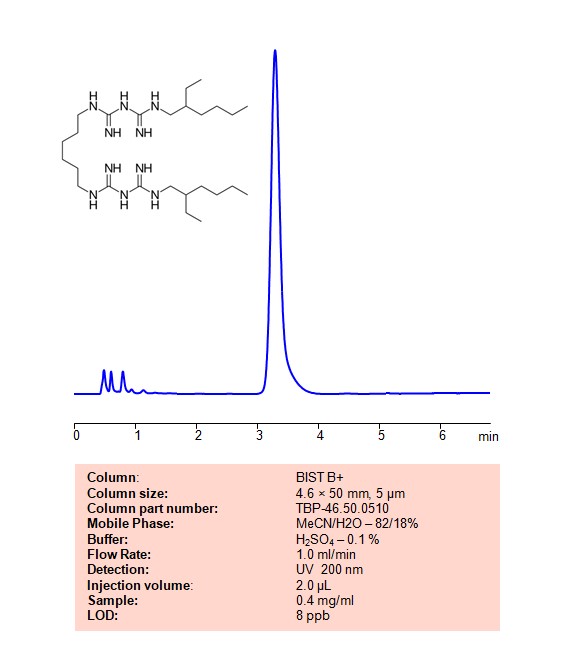High Performance Liquid Chromatography (HPLC) Method for Analysis of Alexidine on BIST B+ by SIELC Technologies
Separation type: Bridge Ion Separation Technology, or BIST™ by SIELC Technologies

Alexidine is a chemical compound that belongs to the class of bis-biguanide antiseptics. It is known for its antimicrobial properties and is used in various products for disinfection and antiseptic purposes. Alexidine has broad-spectrum antimicrobial activity, and it is commonly used in healthcare settings for its effectiveness against bacteria, fungi, and some viruses.
Topical Antiseptics: In some formulations, alexidine is used as a topical antiseptic to disinfect skin and mucous membranes.
Oral Care Products: It is found in some mouthwashes and oral care products due to its antimicrobial properties.
Contact Lens Solutions: Alexidine is sometimes used in contact lens solutions to prevent microbial contamination.
Wound Care Products: It may be included in certain wound care products for its ability to prevent infection.
Alexidine can be retained and analyzed on a BIST B+ mixed-mode stationary phase column using an analytical method with a simple mobile phase of water, Acetonitrile (MeCN) , and a sulfuric acid as a buffer. This analysis method can be detected using UV at 200 nm.
High Performance Liquid Chromatography (HPLC) Method for Analyses of Alexidine
Condition
| Column | BIST B+, 4.6 x 50 mm, 5 µm, 100 A, dual ended |
| Mobile Phase | MeCN – 82% |
| Buffe | H2SO4 -0.1% |
| Flow Rate | 1.0 ml/min |
| Detection | UV 200 nm, UV λmax: 237 nm |
| Sample | 0.4 mg/ml in MeCN/H2O – 82/18% |
| LOD | 8 ppb |
| Injection volume | 2 µl |
Description
| Class of Compounds | Bis-biguanide |
| Analyzing Compounds | Alexidine |
Application Column
BIST B+
Column Diameter: 4.6 mm
Column Length: 50 mm
Particle Size: 5 µm
Pore Size: 100 A
Column options: dual ended





